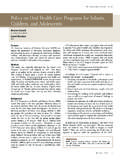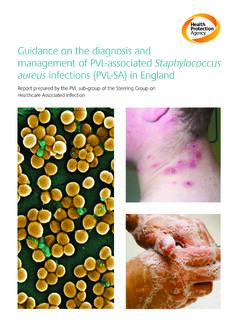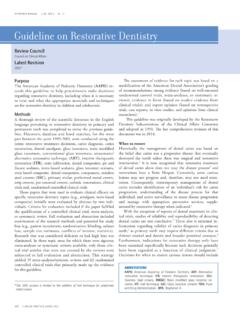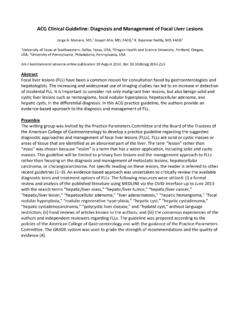Transcription of Guideline on Pulp Therapy for Primary and Immature ...
1 280 CLINICAL PRACTICE GUIDELINES280828 C8 LIN ANPLLLLLRLTELGL ULDLLLLLSDLGLSoPurposeThe American Academy of Pediatric Dentistry (AAPD) intends this Guideline to aid in the diagnosis of pulp health versus pathosis and to set forth the indications, objectives, and therapeutic interventions for pulp Therapy in Primary and im- mature permanent Guideline was originally developed by the Clinical Affairs Committe Pulp Therapy Subcommittee and adopted in 1991. This document is a revision of the previous version, last revised in 2009. This revision included a new systematic litera- ture search of the PubMed electronic data base using the terms: pulpotomy, pulpectomy, indirect pulp treatment, step- wise excavation, pulp Therapy , pulp capping, pulp exposure, bases, liners, calcium hydroxide, formocresol, ferric sulfate, glass ionomer, mineral trioxide aggregate (M TA), bacterial microleakage under restorations, dentin bonding agents, resin modified glass ionomers, and endodontic irrigants; fields: all.
2 Papers for review were chosen from the resultant lists and from hand searches. When data did not appear sufficient or were inconclusive, recommendations were based upon expert and/or consensus opinion including those from the 2007 joint symposium of the AAPD and the American Association of Endodontists (AAE) titled Emerging Science in Pulp Therapy : New Insights into Dilemmas and Controversies (Chicago, Ill.) Background The Primary objective of pulp Therapy is to maintain the integrity and health of the teeth and their supporting tissues. It is a treatment objective to maintain the vitality of the pulp of a tooth affected by caries, traumatic injury, or other causes.
3 Especially in young permanent teeth with Immature roots, the pulp is integral to continue apexogenesis. Long term retention of a permanent tooth requires a root with a favorable crown/root ratio and dentinal walls that are thick enough to with- stand normal function. Therefore, pulp preservation is a Primary goal for treatment of the young permanent dentition. A tooth without a vital pulp, however, can remain clinically The indications, objectives, and type of pulpal Therapy depend on whether the pulp is vital or nonvital, based on the clinical diagnosis of normal pulp (symptom free and nor-mally responsive to vitality testing), reversible pulpitis (pulp is capable of healing), symptomatic or asymptomatic irrever- sible pulpitis (vital inflamed pulp is incapable of healing), or necrotic The clinical diagnosis3 is derived from: 1.
4 A comprehensive medical history. 2. A review of past and present dental history and treatment, including current symptoms and chief complaint. 3. A subjective evaluation of the area associated with the current symptoms/chief complaint by question- ing the child and parent on the location, intensity, duration, stimulus, relief, and spontaneity. 4. A objective extraoral examination as well as examina- tion of the intraoral soft and hard tissues. 5. If obtainable, radiograph(s) to diagnose pulpitis or necrosis showing the involved tooth, furcation, peri- apical area, and the surrounding bone. 6. Clinical tests such as palpation, percussion, and ,4 In permanent teeth, electric pulp tests and thermal tests may be Teeth exhibiting signs and/or symptoms such as a history of spontaneous unprovoked toothache, a sinus tract, soft tissue inflammation not resulting from gin- givitis or periodontitis, excessive mobility not associated with trauma or exfoliation, furcation/apical radiolucency, or radio-graphic evidence of internal/external resorption have a clinical diagnosis of irreversible pulpitis or necrosis.
5 These teeth are candidates for nonvital pulp ,6 Teeth exhibiting provoked pain of short duration relieved with over-the-counter analgesics, by brushing, or upon the removal of the stimulus and without signs or symptoms of irreversible pulpitis, have a clinical diagnosis of reversible pul- pitis and are candidates for vital pulp Therapy . Teeth diagnosed with a normal pulp requiring pulp Therapy or with reversible pulpitis should be treated with vital pulp relevant diagnostic information, treatment, and treatment follow-up shall be documented in the patient s record. Any planned treatment should include consideration of: 1. The patient s medical on Pulp Therapy for Primary and Immature Permanent Teeth review CouncilCouncil on Clinical AffairsLatest Revision2014 AMERICAN ACADEMY OF PEDIATRIC DENTISTRY CLINICAL PRACTICE GUIDELINES 281 2.
6 The value of each involved tooth in relation to the child s overall development. 3. Alternatives to pulp treatment. 4. Restorability of the tooth. When the infectious process cannot be arrested by the treatment methods included in this section, bony support cannot be regained, inadequate tooth structure remains for a restoration, or excessive pathologic root resorption exists, extraction should be ,5,6 It is recommended that all pulp Therapy be performed with rubber-dam or other equally effective isolation to minimize bacterial contamination of the treatment site. This Guideline is intended to recommend the best currently-available clinical care for pulp treatment, but the AAPD encourages additional research for consistently suc- cessful and predictable techniques using biologically-compatible medicaments for vital and nonvital Primary and Immature permanent teeth.
7 Pulp Therapy requires periodic clinical and radiographic assessment of the treated tooth and the support- ing structures. Post-operative clinical assessment generally should be performed every six months and could occur as part of a patient s periodic comprehensive oral examinations. Patients treated for an acute dental infection initially may require more frequent clinical reevaluation. A radiograph of a Primary tooth pulpectomy should be obtained immediately following the procedure to document the quality of the fill and to help determine the tooth s prognosis. This image also would serve as a comparative baseline for future films (the type and frequency of which are at the clinician s discretion).
8 Radiographic evaluation of Primary tooth pulpotomies should occur at least annually because the success rate of pulpo- tomies diminishes over Bitewing radiographs obtained as part of the patient s periodic comprehensive examinations may suffice. If a bitewing radiograph does not display the interradicular area, a periapical image is indicated. Pulp Therapy for Immature permanent teeth should be reevaluated radio- graphically six and 12 months after treatment and then periodically at the discretion of the clinician. For any tooth that has undergone pulpal Therapy , clinical signs and/or symptoms may prompt a clinician to select a more frequent periodicity of reassessment.
9 Apexification, reimplantation of avulsions, and placement of prefabricated post and cores are not indicated for pri-mary teeth. For endodontic procedures not included in this section, the AAPD supports the AAE s Guide to Clinical teethVital pulp Therapy for Primary teeth diagnosed with a normal pulp or reversible pulpitisProtective liner. A protective liner is a thinly-applied liquid placed on the pulpal surface of a deep cavity preparation, covering exposed dentin tubules, to act as a protective barrier between the restorative material or cement and the pulp. Place-ment of a thin protective liner such as calcium hydroxide, dentin bonding agent, or glass ionomer cement is at the discretion of the ,14 Indications: In a tooth with a normal pulp, when all caries is removed for a restoration, a protective liner may be placed in the deep areas of the preparation to minimize injury to the pulp, promote pulp tissue healing, and/or minimize post-operative ,16 Objectives.
10 The placement of a liner in a deep area of the preparation is utilized to preserve the tooth s vitality, pro- mote pulp tissue healing and tertiary dentin formation, and minimize bacterial ,18 Adverse post-treatment clinical signs or symptoms such as sensitivity, pain, or swelling should not pulp treatment. Indirect pulp treatment is a pro- cedure performed in a tooth with a deep carious lesion approximating the pulp but without signs or symptoms of pulp The caries surrounding the pulp is left in place to avoid pulp exposure and is covered with a bio- compatible A radiopaque liner such as a dentin bonding agent,20 resin modified glass ionomer,21,22 calcium hydroxide,23,24 zinc oxide/eugenol,24 or glass ionomer cement7,9,25-27 is placed over the remaining carious dentin to stimulate healing and repair.













